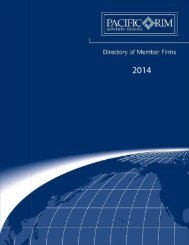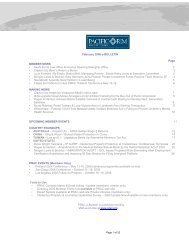A Guide to the Law of Securitisation in Australia - Clayton Utz
A Guide to the Law of Securitisation in Australia - Clayton Utz
A Guide to the Law of Securitisation in Australia - Clayton Utz
- No tags were found...
You also want an ePaper? Increase the reach of your titles
YUMPU automatically turns print PDFs into web optimized ePapers that Google loves.
Despite <strong>the</strong> absence <strong>of</strong> an express approval by a Full FederalCourt, <strong>the</strong> better view is that section 97 <strong>of</strong> <strong>the</strong> 1936 Tax Actshould be <strong>in</strong>terpreted us<strong>in</strong>g <strong>the</strong> proportionate approach. This isalso generally <strong>the</strong> current position <strong>of</strong> <strong>the</strong> <strong>Australia</strong>n Tax Office.Taxation <strong>of</strong> trusts as companiesAs <strong>in</strong>dicated above, it is possible under Divisions 6B and 6C <strong>of</strong><strong>the</strong> 1936 Tax Act for some trusts <strong>to</strong> be regarded as companiesand for tax <strong>to</strong> be levied on <strong>the</strong> trustee (ra<strong>the</strong>r than <strong>the</strong>beneficiaries).Division 6B is unlikely <strong>to</strong> be relevant for securitisation trusts (itusually only applies where, as part <strong>of</strong> a corporate reorganisation,<strong>the</strong> property <strong>of</strong> a company is transferred <strong>to</strong> a public unit trust andshareholders <strong>in</strong> <strong>the</strong> company become entitled <strong>to</strong> take up units <strong>in</strong><strong>the</strong> trust).On <strong>the</strong> o<strong>the</strong>r hand, Division 6C can, <strong>in</strong> some circumstances, apply<strong>to</strong> securitisation trusts. Under section 102S, <strong>the</strong> trustee <strong>of</strong> apublic trad<strong>in</strong>g trust is taxable on <strong>the</strong> net <strong>in</strong>come <strong>of</strong> <strong>the</strong> trust.Section 102N provides that a unit trust is a trad<strong>in</strong>g trust if(among o<strong>the</strong>r th<strong>in</strong>gs), it “carries on a trad<strong>in</strong>g bus<strong>in</strong>ess or, <strong>in</strong> <strong>the</strong>year <strong>of</strong> <strong>in</strong>come, it controlled or was able <strong>to</strong> control, <strong>the</strong> affairs oroperations <strong>of</strong> ano<strong>the</strong>r person <strong>in</strong> respect <strong>of</strong> <strong>the</strong> carry<strong>in</strong>g on by thatperson <strong>of</strong> a trad<strong>in</strong>g bus<strong>in</strong>ess.”A “trad<strong>in</strong>g bus<strong>in</strong>ess” is def<strong>in</strong>ed <strong>in</strong> section 102M <strong>to</strong> mean abus<strong>in</strong>ess “that does not consist wholly <strong>of</strong> eligible <strong>in</strong>vestmentbus<strong>in</strong>ess”, which <strong>in</strong> turn <strong>in</strong>cludes:“(a) <strong>in</strong>vest<strong>in</strong>g or trad<strong>in</strong>g <strong>in</strong> any or all <strong>of</strong> <strong>the</strong> follow<strong>in</strong>g:(i) secured and unsecured loans (<strong>in</strong>clud<strong>in</strong>g deposits with abank, build<strong>in</strong>g society or o<strong>the</strong>r f<strong>in</strong>ancial <strong>in</strong>stitution);(ii) bonds, debentures, s<strong>to</strong>ck or o<strong>the</strong>r securities ...”As can be seen, an eligible <strong>in</strong>vestment bus<strong>in</strong>ess specificallyrefers <strong>to</strong> <strong>the</strong> mak<strong>in</strong>g <strong>of</strong> both secured and unsecured loans.5.2.4 Trust loss provisionsBackgroundIn some circumstances a securitisation vehicle may <strong>in</strong>cur losses orbad debts which it wishes <strong>to</strong> claim as a deduction. In ascerta<strong>in</strong><strong>in</strong>gwhe<strong>the</strong>r a trust can claim a deduction for losses or bad debts,different tests apply depend<strong>in</strong>g upon whe<strong>the</strong>r <strong>the</strong> trust is a fixedtrust (where all <strong>the</strong> <strong>in</strong>come and capital <strong>of</strong> <strong>the</strong> trust are <strong>the</strong>subject <strong>of</strong> fixed entitlements) or a non-fixed trust (all trusts o<strong>the</strong>rthan fixed trusts).The tests which must be passed by a non-fixed trust <strong>in</strong> order <strong>to</strong>claim deductions for prior and current year losses and bad debtsare generally more difficult <strong>to</strong> pass than those applicable <strong>to</strong> fixedtrusts. For that reason, and because <strong>of</strong> <strong>the</strong> issues discussedabove relat<strong>in</strong>g <strong>to</strong> <strong>the</strong> taxation <strong>of</strong> <strong>the</strong> trustees, it is usual, so far aspossible, that trust securitisation vehicles are structured as fixedtrusts.Different types <strong>of</strong> trustsFor fixed trusts, deductions will be denied for tax losses and baddebts if <strong>the</strong>re is no longer a cont<strong>in</strong>uity <strong>of</strong> <strong>the</strong> majority (ie. morethan 50 percent) <strong>of</strong> <strong>the</strong> beneficial ownership <strong>of</strong> <strong>the</strong> trust (<strong>the</strong> 50percent stake test). Ord<strong>in</strong>ary fixed trusts have <strong>to</strong> apply <strong>the</strong> 50percent stake test whenever <strong>the</strong>y wish <strong>to</strong> claim deductions fortax losses and/or bad debts.Different rules apply <strong>in</strong> respect <strong>of</strong> certa<strong>in</strong> unit trusts. Widely heldunit trusts have <strong>to</strong> test ownership when <strong>the</strong>re is any abnormaltrad<strong>in</strong>g <strong>in</strong> <strong>the</strong> units <strong>of</strong> <strong>the</strong> trust or, <strong>in</strong> some cases, at <strong>the</strong> end <strong>of</strong> an<strong>in</strong>come year. Listed widely held unit trusts can avoid <strong>the</strong>consequences <strong>of</strong> fail<strong>in</strong>g <strong>the</strong> ownership test if <strong>the</strong>y pass <strong>the</strong> samebus<strong>in</strong>ess test.In respect <strong>of</strong> non-fixed trusts, deductions for losses and/or baddebts will be denied if <strong>the</strong> 50 percent stake test is failed or ifcontrol (broadly def<strong>in</strong>ed) <strong>of</strong> <strong>the</strong> non-fixed trust changes or, <strong>in</strong>some circumstances, if <strong>the</strong>re is a 50 percent or greater change <strong>in</strong><strong>the</strong> pattern <strong>of</strong> distributions <strong>of</strong> <strong>the</strong> <strong>in</strong>come or capital <strong>of</strong> <strong>the</strong> trust.The trust loss provisions do not apply <strong>to</strong> “excepted trusts” whichare def<strong>in</strong>ed <strong>to</strong> <strong>in</strong>clude fixed unit trusts where <strong>the</strong> beneficiariesare all persons whose <strong>in</strong>come is exempt from tax under section23 <strong>of</strong> <strong>the</strong> 1936 Tax Act or Division 50 <strong>of</strong> <strong>the</strong> 1997 Tax Act.Fixed trusts with non-fixed trust beneficiariesThe relevant tests are more str<strong>in</strong>gent for fixed trusts where <strong>the</strong>beneficiaries who are entitled <strong>to</strong> more than 50 percent <strong>of</strong> <strong>the</strong>trust <strong>in</strong>come or capital are, <strong>in</strong> turn, non-fixed trusts (such ascharitable trusts or discretionary trusts). In <strong>the</strong>se circumstances,<strong>the</strong> non-fixed trust beneficiaries must have held fixedentitlements <strong>to</strong> a 50 percent or greater share <strong>of</strong> <strong>the</strong> <strong>in</strong>come orcapital <strong>of</strong> <strong>the</strong> fixed trust dur<strong>in</strong>g <strong>the</strong> whole <strong>of</strong> <strong>the</strong> relevant testperiod and must pass a “pattern <strong>of</strong> distributions test “ and a“control test”.Briefly, <strong>the</strong> “pattern <strong>of</strong> distributions test “requires that 50percent or more <strong>of</strong> <strong>the</strong> distributions made by <strong>the</strong> non-fixed trusthave been <strong>to</strong> <strong>the</strong> same <strong>in</strong>dividuals (mean<strong>in</strong>g natural persons) for<strong>the</strong>ir own benefit dur<strong>in</strong>g <strong>the</strong> six year period prior <strong>to</strong> <strong>the</strong> year <strong>of</strong><strong>in</strong>come <strong>in</strong> question.30






